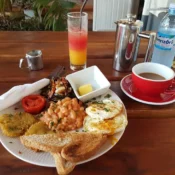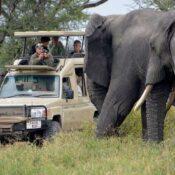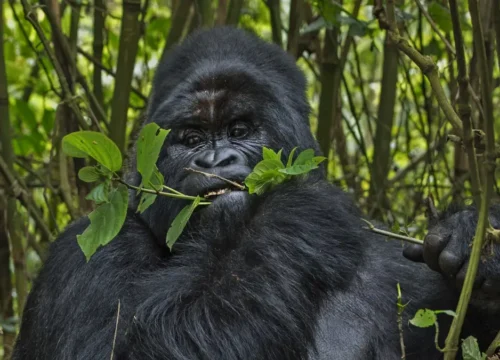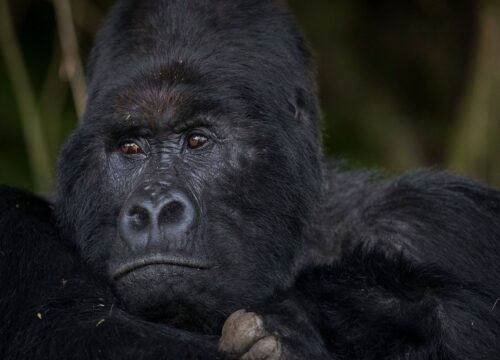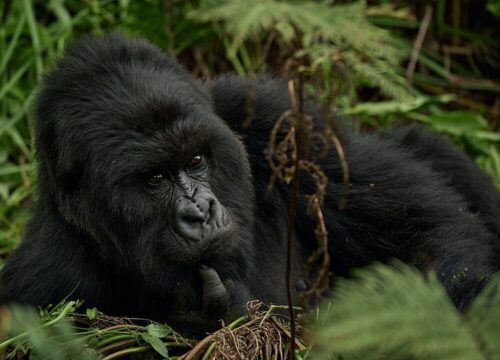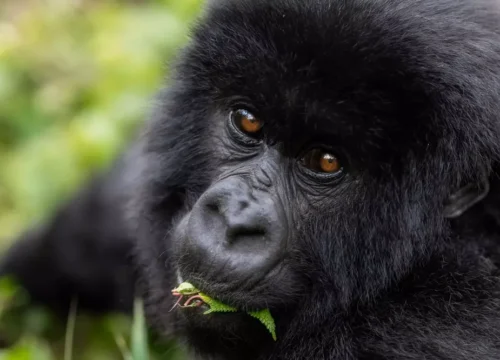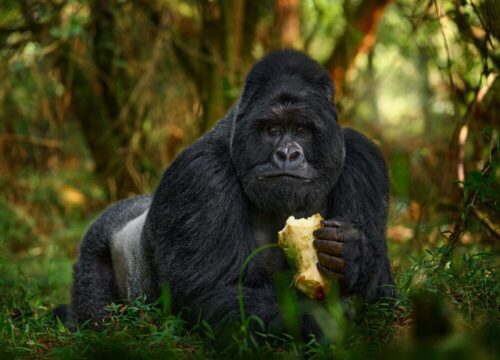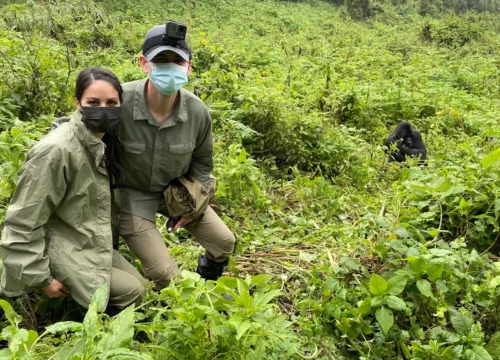Victoria Falls Top 10 Fun Facts
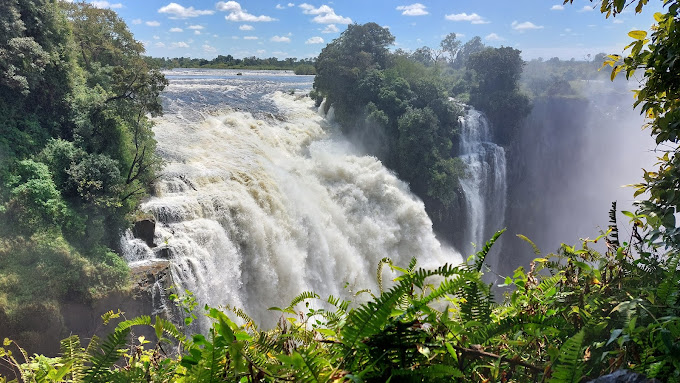
One of the Seven Natural Wonders of the world and one of the greatest and most famous discoveries of Explorer David Livingstone, the Victoria Falls is also known as the “Smoke that thunders” in the local Tonga language. This Victoria Falls Top 10 Fun Facts article details the Fall being the largest single curtain of falling water in world and 70% of the exquisite views are seen from the Zimbabwe Rain Forest.
The majestic Victoria Falls are obviously a must visit and must see destination in Southern Africa, the fall is on almost everyone’s bucket list. Victoria Falls are impressive and the perfect halfway point on your holiday journey across Southern and East Africa.
Victoria Falls are located on the border between Zimbabwe and Zambia in Southern Africa, this awe-inspiring waterfall is a must – visit destination for nature enthusiasts and travelers seeking for a travel experience unlike any other.
Though they are not the widest or tallest waterfalls in the world, Victoria Falls are the largest falling sheet of water in the world which earns it the honor of being the largest waterfall in the world
In this blog, we have uncovered 10 things you probably did not know about Victoria Falls
First Discovered by European Eyes in 1855
The Victoria Falls were first seen by European eyes when David Livingstone discovered them in 1855, to view this magnificent falls he stood upon what is now known as Livingstone Island – a small outcrop of land at the edge of the Falls, in Livingstone, Zambia.
Without the Zambezi River, The Falls would not exist
The Victoria Falls are part of the 2,574 km stretch of the Zambezi River and lie almost exactly half way of the river, with the Zambezi the leaving the falls and making its way east to flow into the Indian Ocean.
The Flow of the Zambezi and Water Levels Change
The flow of the Zambezi River lessens and the water level drop from September to December, this allows daredevils to swim to the very edge of the Victoria Falls in a naturally formed pool and look down into the chasm below.
The pool named “Devil’s Pool” is made by a rock wall that halts the current enough for a swim.
The Falls Area 1,708 Meters Wide and 108 Metres High
Though Victoria Falls are known as the world’s largest waterfall, it is neither highest like Angel Falls nor the widest like Khone Falls. However, it is the largest curtain of falling water on the planet, one and a half times wider than Niagara Falls and twice as high.
On The Zimbabwean Side of The Falls Lies The Victoria Falls Rainforest
The Victoria Falls Rainforest is a special place is home to unique plant and animal life, some of which are indigenous to the area. Their environment is one equally unique as it “rainforest” is the only place on earth where it rains all day, every day. This daily rainfall is a direct result of the water vapour rising from the falls, which then falls as rain in the rainforest.
Victoria Falls is Home To A “MoonBow” Which is A Rainbow At Night
As the sun sets on the a full moon, the might Victoria Falls hosts a rare and beautiful sight as the light from the moon boucing off the spray gives life to a “moonbow”, a rainbow during the night.
This out of the world spectacle lasts from sunset to sunrise and is one of Africa’s most distinctive and striking secrets.
Victoria Falls Has a Different Indigenous Name
Before exploring the area and witnessing the Victoria Falls for himself, David Livingstone had already heard tales of the mighty waterfall. Although at that time, the falls weren’t called Victoria Falls. The locals had named it Mosi-oa-Tunya which mean “The Smoke That Thunders”.
Explorer Livingstone renamed the falls in honor of Queen Victoria.
Every Minute, Over 5 Million Cubic Metres Of Water Pour Over The Falls
The Victoria Falls cascades into a gorge over 100 meters deep during the wet season. The opposing cliffs that comprise the gorge are made from basalt and rise to the same height.
One Of The Seven Natural Wonders Of The World
Victoria Falls join the Great Barrier Reef, the Grand Canyon, the Aurora Borealis, the Paricutin Volcano, the Harboir of Rio de Janeiro and Mount Everest as the Seven Natural Wonders of the World.
Victoria Falls Sits On The Very Border Of Zambia And Zimbabwe
The Zimbabwean side is the best place to view the Victoria Falls face-on, spray from the Falls will leave you drenched particularly on the Zimbabwean side. So be sure to pack waterproofs.
If you are trying to decide where to stay, there are several accommodation options to stay at.
A holiday to The spectacular Victoria Falls is a magical experience and the falls are an ideal destination for travelers looking for an active holiday. There are so many ways in which to discover the Victoria Falls including a helicopter ride over the top, bungee jumping off Victoria Falls Bridge, jet boating and white water rafting.
Victoria Falls is a perfect destination for a honeymoon holiday in Zambia or Zimbabwe.
The Best Time To Visit Victoria Falls
If you want to see Victoria Falls at its highest with massive water sprays-such that you will probably want bring a rain jacket. The best time is April – June, this is also when you are more likely to see a rainbow.
For the best visibility, July – August as water levels are at their lowest. July and August are also peak season for visiting Victoria Falls and the rest of Zimbabwe.
For excellent visibility at Victoria Falls is September through November as the falls are at lower level. This is the best time to visit Victoria Falls if you plan to visit the Devil’s Pool on the Zambia side of the Victoria Falls as this requires water to be at their lowest seasonal levels.
End of Victoria Falls Top 10 Fun Facts
GENERAL INFORMATION
ENTRY REQUIREMENTS:
All visitors to Victoria Falls must have a valid passport with at least 4 consecutive blanks pages. The Government of Tanzania has rolled out an online Visa application portal accessible on internet. Any applicable visa and/or relevant documentation are the responsibility of the traveler. For further information on Visa requirements visitors are advised to contact their nearest Zimbabwe Embassy or Consulate.
LANGUAGE: English
TIME: GMT +3
CLIMATE: Southern Africa climate is predominantly tropical. The long rains are from mid-March to late May and the short rains from November to January. The hottest months are from October to February and the coolest months are June to August.
VOLTAGE: 220 Volts/AC50Hz. Sockets are UK style, 3 pin square plugs. Power is from the National Grid in the city/major towns and generator with inverter back up in the Safari Lodges and Camps.
CURRENCY: Foreign currency must be changed at the Bank, Bureau de Change, and Hotel/Safari lodge/Camp/Resort. Major Credit Cards, Master card, Visa, American Express, are usually accepted throughout the country. Where credit cards are accepted, the payment will normally be recorded in US$ regardless of the card’s default currency. However, US$ older than 2009 are only accepted
CLOTHING: Dress is mainly informal and should be comfortable as well as practical. Something warm should be brought along for early morning and evenings. Safari clothes are available from hotels/lodges/camps.
BAGGAGE: Where possible, travel light. Baggage space on safari is limited to medium suitcase or soft bag per person plus reasonable amount of hand luggage. There is 15 Kilogram per person limit on all flights to the wildlife sanctuaries. Excess luggage must be stored in your arrival hotel.
WATER: You will find many different of opinion of what is safe and what is not. We recommend for peace of mind, to drink local Bottled Mineral water. It is important to drink plenty of water especially during the hotter months. We would recommend that guests drink at least 2 to 3 litres of water per day to limit the effects of dehydration.
HEALTH: East Africa is a safe and secure destination; however, it is a good idea to take a few precautions. Kindly consult your GP or local doctor at least 6 weeks before you travel, with regards:
Malaria prophylactics. East Africa is a known malaria area and preventive measures are essential. You are advised to take one of the recommended anti-malarial drugs. Be sure to wear long sleeved shorts and trousers after sunset and spray the exposed parts of your body with a mosquito repellent spray. The hotels provide mosquito repellent sachets as part of the room’s amenities in all our locations.
Remember to protect yourself from direct sun rays with sunscreen cream or safari hat.
DIETARY REQUIREMENTS: For those guests with specific dietary requirement, please ensure Imbasa is notified prior to travel so that the respective Hotels and Lodges are informed
GRATUITIES: As a guideline and dependent on how happy you are, we would suggest the following:
The General Hotel/Lodge/Camp Staff – Approximately U$ 10.00 per person per day
Driver Guides – Approximately US$ 15.00 to US$ 20.00 per person per day
PHOTOGRAPHY: Please be careful when photographing public buildings, airports, bridges, the national flag and people in uniform. Ensure that you have sought permission before photographing local people and their villages. If in doubt, please check with your guide.
Read about
10 Things you Should NOT DO on an African Safari.
What to expect on a safari in Uganda.
Bwindi Impenetrable National Park
How to Choose the Best Tour Operate for Your Safari in Africa
12-Day Gorilla Tracking in Bwindi
East African Safaris
1 Day Jinja Ultimate tour Experience
1 Day White Water Rafting in Jinja
3 Days Bwindi Gorilla Habituation via Rwanda
3 Day Birding Safaris and Photography in Uganda
3 Day Safari to Queen Elizabeth National Park
3 Day fly in Gorilla Trekking Safari from Masai Mara
3 Day Grand Gorilla Trekking Safari
4 Day Chimpanzee and Gorilla Trekking Safari
4 Day Murchison Falls and Jinja tour
Packages with Gorilla Trekking
1 Day Uganda Gorilla Trekking Safari from Kigali Rwanda
3 Days Fly in Gorilla Habituation Safari
3 Days Budget Gorilla Safari in Uganda
3 Days Customizable Rwanda Gorilla Tracking Safari
3 Days Gorilla Trekking Experience and Lake Bunyonyi
3 Days Last Minute Gorilla Trekking & Lake Bunyonyi in Uganda
3 Days Rwanda to Uganda Gorilla Safari
3 Days Uganda Gorilla Safari from Kigali
4 Days Gorilla and Golf Safari in Uganda
4 Days Rwanda Gorilla Adventure
5 Day Gorillas and Game Drive Safari
5 Days Golf and Gorilla Safari in Uganda
5 Days Rwanda Gorillas and Culture Tour
6 Day Uganda Gorilla and Wildlife Tour
6 Days Budget African Safari with Gorilla Trekking
7 Days Gorilla and Chimpanzee Trekking in Uganda
7 Days Uganda Budget Gorillas and Primate Trip
8 Days Gorilla Trekking Vacation to Bwindi National Park
8 Days Uganda Gorilla and Chimpanzee Safari
10 Days Rwanda and Uganda Gorilla Safari
14 Days Uganda Rwanda Study Tour & Gorilla Trekking Trip
Best African Destinations Itineraries
Southern Africa Destination Itineraries
Eastern Africa Destination Itineraries
Northern Africa Destination Itineraries
Indian Ocean
Recent Posts
Last Minute Deals
Quick booking process
+49 1575 4711313


